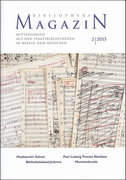Using RISM for Genealogy
Peter Teuthorn
Thursday, August 6, 2015

This article by Peter Teuthorn was originally published in his Genealogie-Feuilleton in an earlier form and is reprinted here with kind permission.
Compositions by Christian Balthasar Teuthorn found using RISM
Today’s genealogy no longer wears itself out by piling up ancestry data. Genealogists now look at the social context of the times in which their relatives lived. As digitization facilitates access to libraries, allows archival materials to be discovered through finding aids, and fosters virtual subject collections, tools open up for genealogists to catch a glimpse into the daily life of times past and the cultural environment of their ancestors. Such sources could be unlocked in the pre-digital world only with a bit of effort. And music can also play a role here.
On pages 10-13 of Bibliotheks-Magazin (issue 2/2015), Reiner Nägele reports on the Virtual Library of Musicology (ViFaMusik) at the Bavarian State Library (BSB) in Munich. His account gives us a look inside the complexities of national and international musicology.
For the genealogists who can count musicians among their relatives as well as historians who are interested in the subject, the RISM online catalog is an important tool. The BSB is responsible for the technical implementation of this catalog.
A search in the International Inventory of Musical Sources (RISM /Répertoire International des Sources Musicales) consolidates the treasures of individual archives and promises concise information with interesting results. Using RISM, it was possible for me to find - in one search - records for the sonatas, polonaises, and songs for piano, violin, and voice by Christian Balthasar Teuthorn.
Information about access to the RISM catalog is also on the BSB’s website. The search results show information about each work and the locations of the archives, as can be seen below:

Copies of the Romance and the Polonaise for keyboard or harpsichord had previously been provided to me very kindly and without any bureaucratic hurdles by the Statsbiblioteket Århus.
Share Tweet EmailCatégorie: A la une

